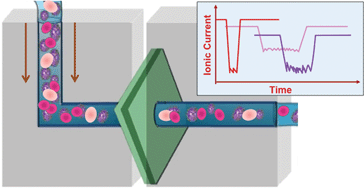Electrophysiological analysis of biopsy samples using elasticity as an inherent cell marker for cancer detection
Abstract
Biopsy samples from patients are valuable for diagnosis. Herein, a label-free approach for the early diagnosis of cancer from biopsied samples is reported. The scheme relies on single solid-state micropores as the transducer component and cell elasticity as the indicator of cell health. The biomechanical discrimination of cancerous cells depends on purely intrinsic properties and is not limited by the availability of biomarkers. As a model, bladder cancer cells, which are very different from healthy cells, showed specific electrical signatures. The correlated detection of tumor cells was performed with an efficiency of 75%. The difference in cellular elasticity afforded one order of magnitude lower translocation time for tumor cells. The capability to recognize very few tumor cells solves the prime challenge in biopsy exams. A comparison of the motility and stiffness of cancer and normal urothelial cells showed distinctive quantifiable viscoelastic behavior.


 Please wait while we load your content...
Please wait while we load your content...